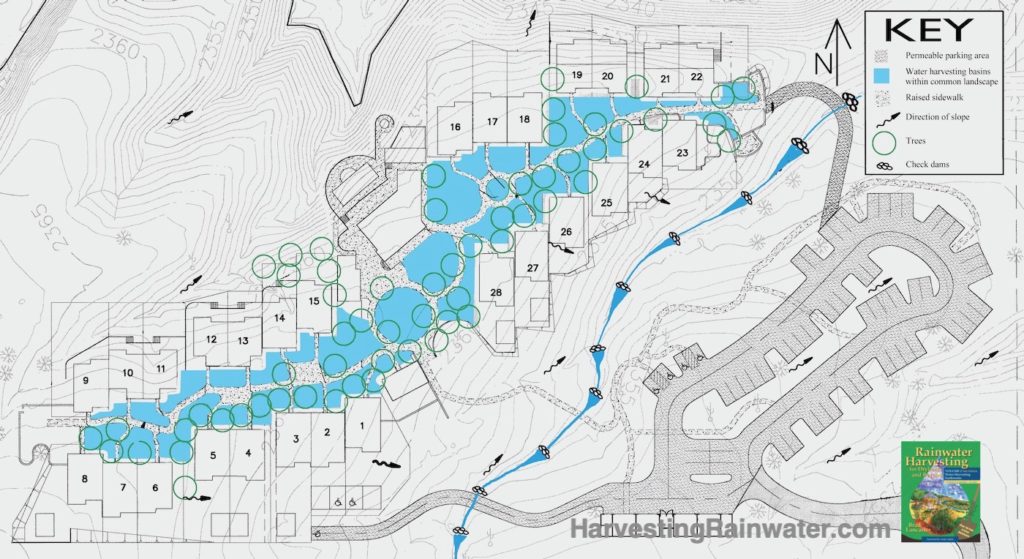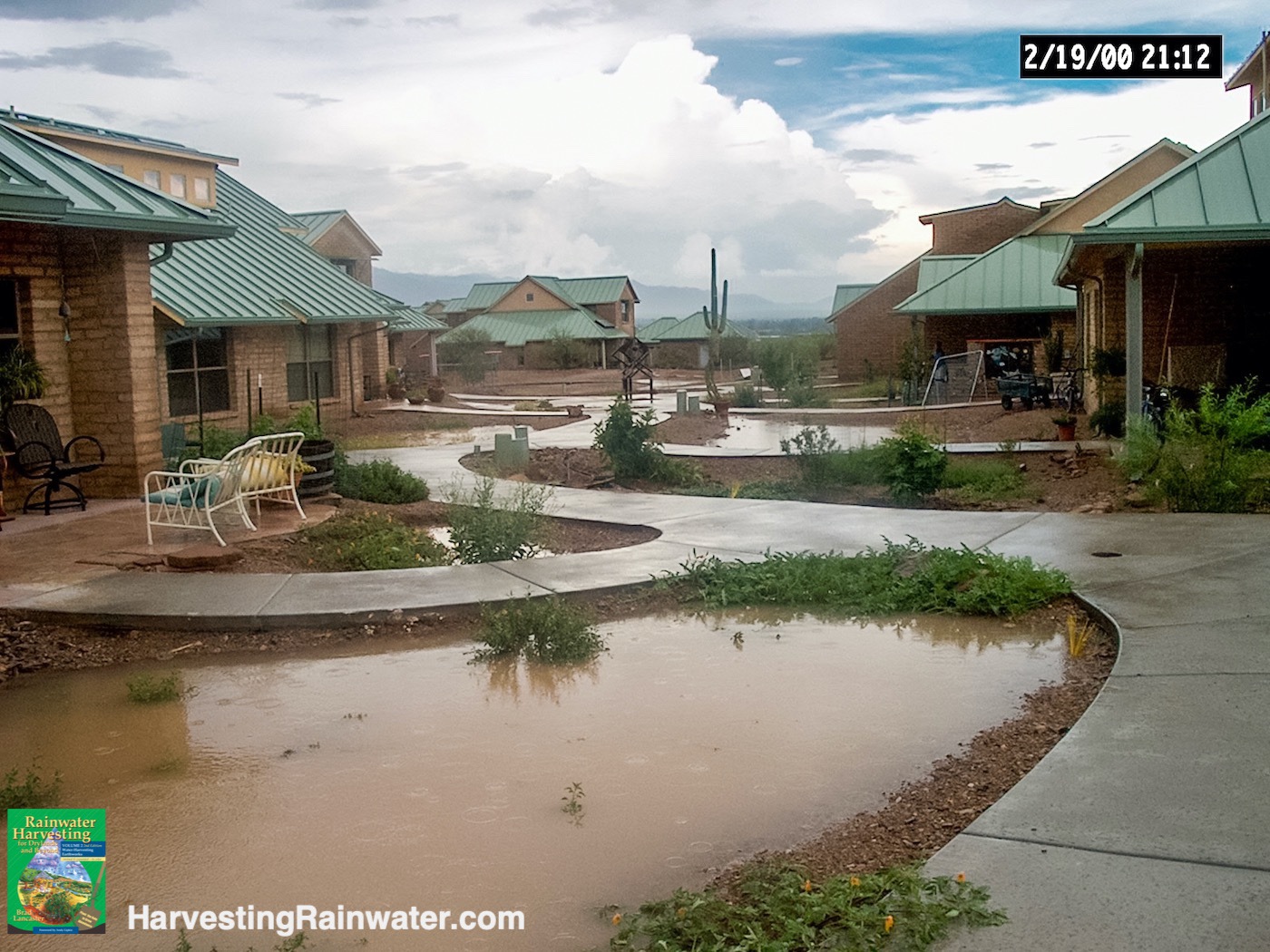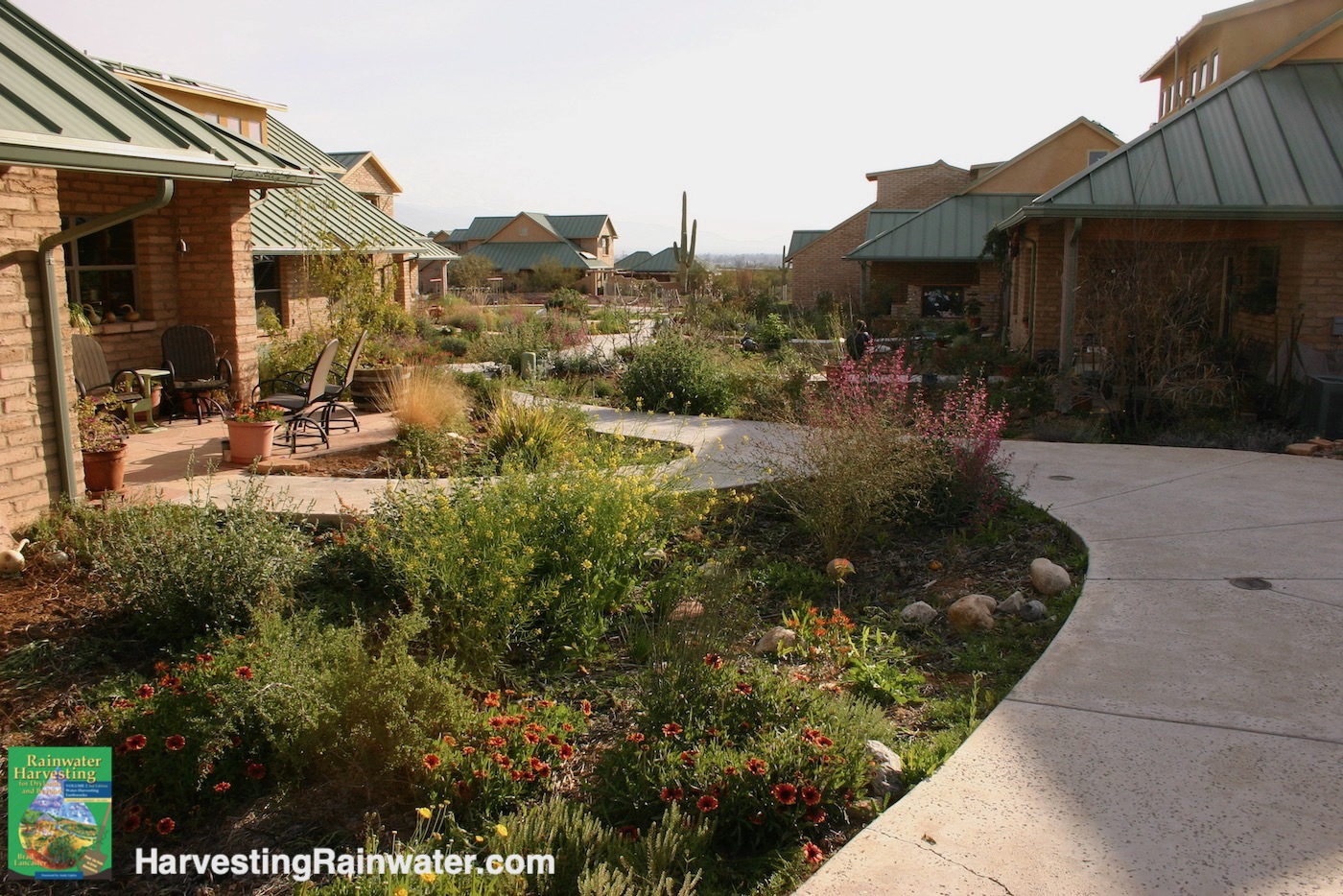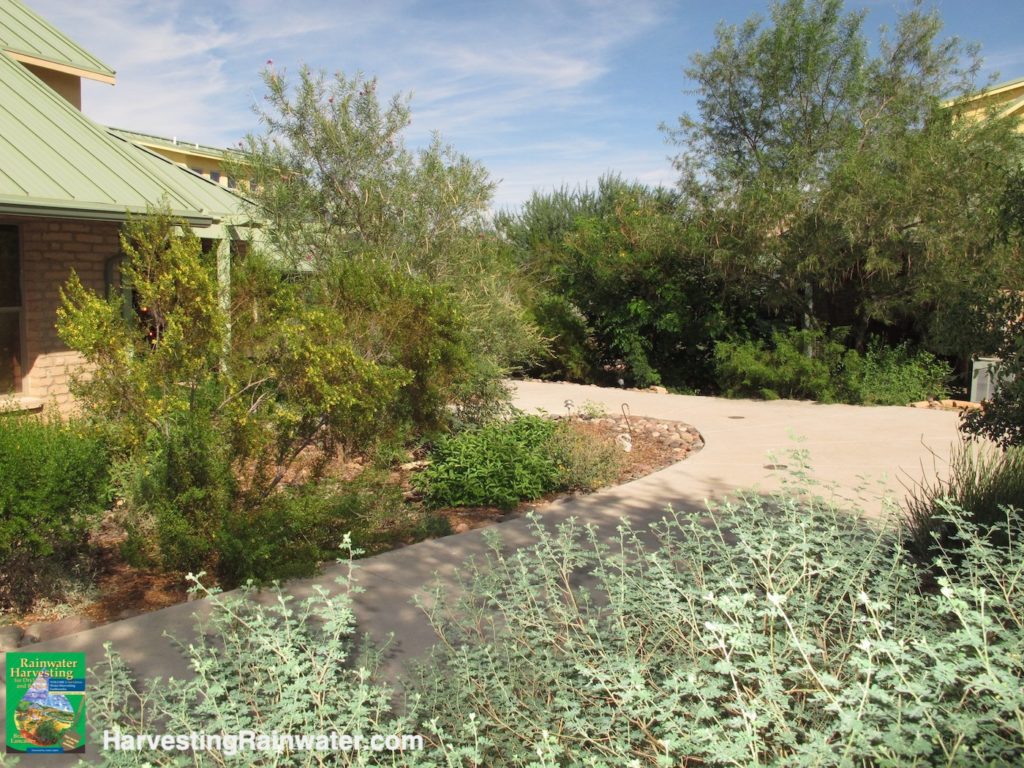Milagro Co-housing Community & its passive water harvesting
The 28-home Milagro Cohousing development in Tucson illustrates the effectiveness of integrating water-harvesting infiltration basins throughout a site from the creation of the site’s plans all the way through build-out. There are no conventional detention or retention basins at the bottom of the Milagro development. Instead, dozens of rain gardens/infiltration basins are grouped and scattered throughout the site’s landscape. They are the dominant landform throughout the common area landscape, and in many backyards.

There is no large stormwater-detention/retention basin(s) at the bottom of this site because dozens of small, landscaped, infiltration basins infiltrate and utilize all the runoff beginning at the top, and continuing throughout, the development.
Although unmarked, there are also infiltration basins in many residents’ back yards. Trees were selected and placed in the plan to maintain winter solar access to south-facing windows.
Reproduced with permission of Tomas Guido Jr., TnT Engineering and modified by Brad Lancaster and Joe Marshall
Raised pathways divide up the Milagro landscape into an integrated series of water-harvesting basins; which hold the rain that falls within them, roof runoff, sidewalk runoff, and leaf drop. Diverse arrays of food-producing, wildlife-attracting plants are planted within the basins to utilize this rainwater. Organic-matter mulch then covers the soil’s surface to make that rainwater go further.
Some homeowners direct their roof runoff to above-ground cisterns first, which then direct their overflow to the basins. The cistern water is then doled out in the dry seasons to irrigate more water-needy plants such as vegetables.

The basins have not yet been mulched or planted.
Milagro Cohousing, Tucson, Arizona.
Photo: Natalie Hill.

These basins—with their spongy mulch, soil-burrowing plant roots, and healthy soil life—infiltrate all water within 20 minutes.
Photo: Brad Lancaster, taken November 2004

Photo: Brad Lancaster
In the unlikely event the basin system overflows, each basin overflows to the next to manage the excess water. The concrete sidewalks of the raised paths act as stabilized spillways between basins and dip slightly where surplus water is meant to pass. The final overflow exits from the lowest basins into a natural waterway, which is alive with undisturbed, established vegetation that is enhanced by a series of small water-harvesting check dams. That rainwater and wastewater alone are enough to enable the designed landscape to produce 100 pounds (45 kg) of organic produce per resident per year.
This system of infiltration basins holds approximately ten times more stormwater than a conventional system of flood-control retention basins, though it does far more than control flooding. By integrating water-harvesting basins throughout the landscape, flood-control strategies double as the foundation of a passive rainwater-irrigation system that nurtures a community orchard, gardens, native-wildlife habitat, and living air conditioners in the form of shade trees.
See a video tour below…
Other on-site waters harvested (or that could be harvested)
Household greywater could also be directed for free with gravity to these basins (as described in chapter 12 of Rainwater Harvesting for Drylands and Beyond, Volume 2, 2nd Edition) to act as a supplemental irrigation source.
However, at the time of construction, such a greywater system was not yet legal. (Inexpensive gravity-distributed, tankless greywater harvesting is now legal—see chapter 12 of Rainwater Harvesting for Drylands and Beyond, Volume 2, 2nd Edition for the legalization story and how to implement these practices).
So, Milagro treats all its wastewater on site via a constructed wetlands at the bottom of the site, then pumps the water back up to subsurface irrigation lines 8 inches (20 cm) beneath the bottom of the basins. This recycled water is a great boon for the landscape, but it does introduce unwanted salts to the soil, just as greywater would. But the rainwater again saves the day, since it flushes the salts from the root zone of the plants each time it fills the basins.
(If residents were up for it, they could now redirect their household greywater direct to the landscape via gravity, since the laws have changed. But it is more costly to do so as a retrofit than it is during initial construction). No worries, with both new construction and retrofits, the City’s greywater harvesting rebate will pay up to $1,000 per residence implementing a greywater-harvesting system.
David Confer and I designed the layout of basins and landscaping to maximize rainwater use in the landscape, keep the water needs of the landscape within the available free on-site water supply (rainwater, stormwater, treated household “waste” water) provide shade trees for passive cooling, and maintain winter solar gain for south-facing windows. Civil Engineer Tomas E. Guido Jr. of TnT did the engineering.
Some issues/potential improvements
Over the years some residents started to fill in some of the public water-harvesting basins, sometimes by importing gravel. This was against the community’s policy, and in violation of the project’s building permit because it weakened the project’s flood control system and the health and performance of the community landscape.
The community eventually restarted the enforcement of its own rules, and some repairs were done, but as of yet, not in full. It seems that the Commons thrive when we are all engaged, communicating, and holding ourselves to our community commitments and responsibilities; but the tragedy of the commons begins when we disengage, stop communicating, and allow commitments and responsibilities to slide. Thankfully we can always reengage. The sooner, the better.
The residents of the community implemented the plantings in the design, and in so doing sometimes altered the design by changing the placement and selection of some of the plants. Sometimes this improved things. Sometimes it created challenges. One change of concern is a couple of non-native South American-hybrid mesquite trees were planted instead of the desired/designed native velvet mesquite trees (Prosopis velutina). The non-native mesquites have heaving root systems that will likely heave sidewalks and building foundations, whereas this would not have been a problem with native velvet mesquites. Additionally, non-native mesquite trees only support about 12 native pollinator species, while the native mesquites support over 60. And the native mesquite trees reliably drop their leaves in winter allowing for the sun to provide free heat and light when needed.
See here for more info on the different kinds of mesquites planted in southern Arizona and how to identify which is which.
When designing the landscape, it was hard to estimate how much water would be available from the constructed wetlands for reuse as irrigation water. So, we were conservative in selecting the plants used in the common landscape. In hindsight, we could’ve planted more fruit trees than we did.
For more information visit MilagroCohousing.org.
Where:
3057 N Gaia Pl, Tucson, AZ 85745
32.26266727425929, -111.0292465442494
Please respect the privacy of this community, and do NOT visit in person, unless you have arranged a tour with the Milagro community – see below.
For more…
This location is included in the following tours:
See the new, full-color, revised editions of Brad’s award-winning books
– available a deep discount, direct from Brad:

Volume 1
This is THE book to start with.
It shows you how to assess your free, on-site waters, then create an integrated plan to harvest them in a way that grows many other resources such as passive summer cooling and winter heating, food, wildlife habitat, livestock fodder, joy, and more.

Volume 2
This book shows you how to create many different water-harvesting earthworks or rain gardens for many different contexts and situations – including Milagro and other housing developments and residences in both the urban and rural setting.
It also includes a chapter on greywater harvesting and an appendix on dark greywater harvesting.
